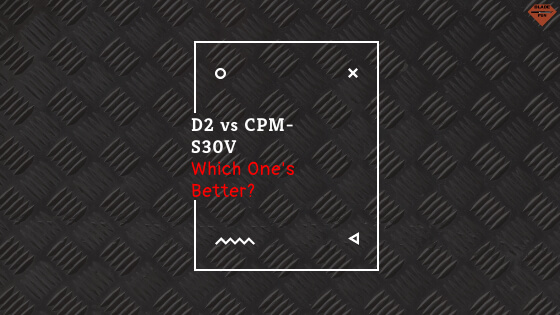D2 and S30V are both higher tier knife steels. They aren’t the highest you can go, but they’re still pretty up there.
When it comes to the differences between the two, here’s the TL:DR version:
S30V is a higher-tier knife steel compared to D2. It generally has higher corrosion resistance, toughness, ease of sharpening, and edge retention. It’s a really well-balanced steel, but it’s more expensive. D2 is cheaper, but not as good as S30V as it rusts easier and is harder to sharpen.
Of course, we can go deeper than that. Let’s check out some more features and differences of the two knife steels.
D2
First of all, it should be stated that comparing steel in a vacuum usually doesn’t compare to real life. There are a lot of other things that go into knife steel that can affect the real-world performance like edge geometry, who made it, the heat treat, etc.
That being said, D2 is a cheaper steel compared to S30V and is a tad bit inferior. It’s roughly as tough as S30V and holds an edge about as long, but it doesn’t have the same corrosion resistance or ease of sharpening. It doesn’t quite meet the chromium requirements in order to be considered a stainless steel (and thus suffers from a lack of corrosion resistance).
D2 also can sometimes run into a chipping problem if you use too much pressure when you sharpen the blade. Using too much pressure can result in microchips and microcracks that you won’t be able to see. When you use the blade on more strenuous activities, those microchips and microcracks can turn into big chips and cracks that you can see.
The chances are good that you won’t notice as much of a difference between S30V and D2 aside from the corrosion resistance. If you need a corrosion-resistant knife, then you’re either going to have to maintain the blade and put mineral oil on it from time to time or look for a different knife steel.
D2 vs CPM-D2–is there a difference?
Another thing you might see when looking in the D2 category is CPM-D2. There’s not much of a difference here. The only difference is the way that they’re made.
CPM-D2 is made in a way that makes it more consistent, meaning that it’ll be consistently tough across the whole blade. D2 can sometimes be inconsistently tough, which can lead to worse performance. You likely won’t notice much of a difference, but if you get the option, choose CPM-D2 instead of D2.
S30V
S30V is the higher quality of the two here. It’s going to be more corrosion resistant, easier to sharpen, will be slightly tougher, and will slightly hold a better edge.
For S30V, the S stands for “Stainless” and the V for “Vanadium.” Stainless means it’s more resistant to rust, while vanadium is an element put into steel to help with wear resistance and strength. The number doesn’t do anything aside from differentiate it from other steels of relatively the same class (like, say, S90V).
While both have about the same level of carbon (about 1.5-2%), which increases strength and toughness (it’s important to note that too much carbon can lead to a weaker blade), S30V has more vanadium and chromium. Vanadium leads to more strength and hardness. Chromium is for corrosion resistance.
What that basically all adds up to is that S30V is stronger and more corrosion resistant than D2. But of course–as with a lot of things–that increased quality means an increased price tag.
But again, that can all change in the real-world. Who makes the steel, the heat treat, the edge geometry, the maintenance, and more are all likely to cause the performance of the two steels (and even two of the same steels!) to vary.
If you’re looking for a higher quality steel and don’t care about the price, go with the S30V. You probably won’t notice too much of a difference in real-world performance, but S30V is going to generally be better.
S30V vs CPM-S30V–is there a difference?
Unlike D2 and CPM-D2, there isn’t a difference between S30V and CPM-S30V.
S30V and CPM-S30V are the same steel, but with different names. Some companies, groups, people, etc. refer to the steel as S30V and others as CPM-S30V, but it’s the same thing.
Basically…
If money isn’t an obstacle for you, go with the S30V. If it is, go with D2. If corrosion resistance and price are an issue for you, then either go look for another steel or be prepared to do some upkeep with your D2 steel (like putting mineral oil on it) so it doesn’t rust.
If you’re interested in checking out some knives with S30V, D2, or a different kind of steel, we’ve got a bunch of knife reviews. Just click here and check them out!

